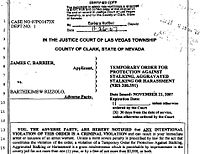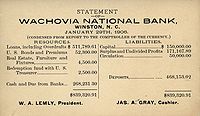Document
  
|
|
| Several common types of documents: a birth certificate, a legal document (a restraining order), and a bank statement. |
A document is a written, drawn, presented or recorded representation of thoughts. Originating from the Latin Documentum meaning lesson - the verb doceō means to teach, and is pronounced similarly, in the past it was usually used as a term for a written proof used as evidence. In the computer age, a document is usually used to describe a primarily textual file, along with its structure and design, such as fonts, colors and additional images.
The modern term 'document' can no longer be defined by it transmission medium (such as paper), following the existence of electronic documents. 'Documentation' has more meanings than a written or drawn presentation of thoughts.
The formal term 'document' is defined in Library and information science and in documentation science, as a basic theoretical construct. It is everything which may be preserved or represented in order to serve as evidence for some purpose. The classical example provided by Suzanne Briet is an antelope: "An antelope running wild on the plains of Africa should not be considered a document, she rules. But if it were to be captured, taken to a zoo and made an object of study, it has been made into a document. It has become physical evidence being used by those who study it. Indeed, scholarly articles written about the antelope are secondary documents, since the antelope itself is the primary document." (Quoted from Buckland, 1998 ). (This view has been seen as an early expression of what now is known as actor–network theory).
The concept of "document" has been defined as “any concrete or symbolic indication, preserved or recorded, for reconstructing or for proving a phenomenon, whether physical or mental" (Briet, 1951, 7; here quoted from Buckland, 1991).
A much-cited article asked "what is a document[?]" and concluded this way: “The evolving notion of ‘‘document’’ among (Jonathan Priest). Otlet, Briet, Schürmeyer, and the other documentalists increasingly emphasized whatever functioned as a document rather than traditional physical forms of documents. The shift to digital technology would seem to make this distinction even more important. Levy’s thoughtful analyses have shown that an emphasis on the technology of digital documents has impeded our understanding of digital documents as documents (e.g., Levy, 1994). A conventional document, such as a mail message or a technical report, exists physically in digital technology as a string of bits, as does everything else in a digital environment. As an object of study, it has been made into a document. It has become physical evidence by those who study it.
...
Wikipedia
